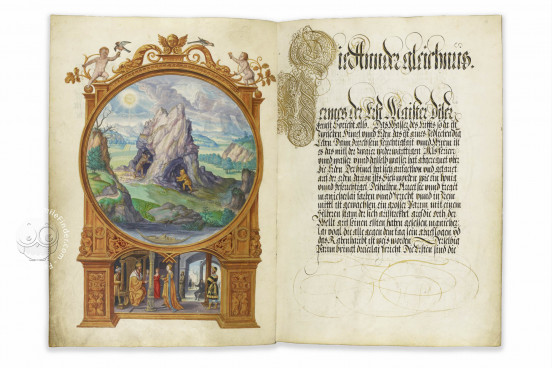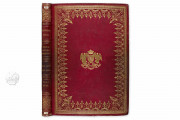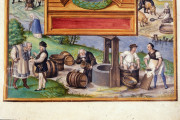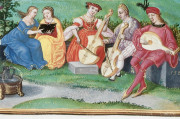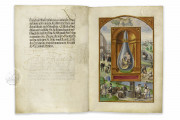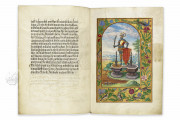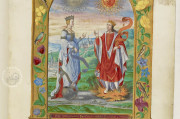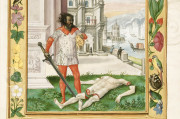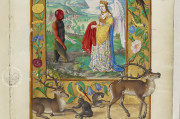The London Splendor Solis is the most spectacular extant manuscript of the German treatise known as Splendor Solis oder Sonnenglanz. The text somewhat cryptically describes the art of alchemy: the transformation of matter from earthly existence by initiated practitioners. The manuscript, dated 1582 and originating in Germany, features twenty-two full-page miniatures of often enigmatic content and dozens of elaborate calligraphic initials in gold.
The London manuscript is one of three illuminated copies of the text that derive from a shared exemplar of 1545. The other closely related manuscripts are the Aurora Consurgens in Berlin and the Paris Splendor Solis.
Let Us Inquire into the Nature of Elements
One of the opening miniatures depicts an alchemist situated in a deep illusionistic landscape (fol. 4r). He holds a flask containing a golden substance and to which is attached a long fluttering ribbon with a message in Latin in gold lettering: "Let us inquire into the nature of elements."
Decorated and Historiated Borders
The manuscript's miniatures, which conclude or introduce numbered text sections, show many of the ideas and stories related in the proximate text. All feature full borders, some in the vein of Flemish borders populated by naturalia, others historiated, and some forming elaborate architectural surrounds.
Mining for Gold
The alchemist's interest in the many properties of substances is revealed in the miniature and historiated border that concludes a "parable" about the earth (fol. 13v). The miniature of two men quarrying gold from a mountain in a deep landscape is paired with a bas-de-page scene of the Persian king Xerxes (d. 465 BCE) raising his golden scepter to Esther—a sign that would lead to the prevention of a massacre of Jews—as told in the Hebrew Bible. The gold rod in the biblical scene is meaningful beyond the value of the quarried ore.
Personifications Coupled with the Everyday
A series of historiated borders include classically inspired personifications of heavenly bodies drawn by chariots above the miniature (fols. 23r, 24r, 25r, 26r, 27r, 28r, and 29r). These pages feature quasi-narrative scenes in the lower border that include various quotidian subjects, such as battles, fishing, bell-forging, and parchment making. Each miniature shows a human figure or other creature in an alchemist's flask.
A Showpiece of Calligraphy
The script is Fracture, a stylized Gothic Hybrida, with strong thick-thin contrast and many delicate looping flourishes. Swooping spirals of gold embellish the black text. In addition, there are dozens of enlarged gold letters composed of broad and fine pen strokes formed into compositions of parallel thick straps surrounded by delicate filigree.
Fit for a King
The manuscript came into the possession of Charles II (1633-1701), King of England, before then passing through the hands of Johann Cyprian (1642-1723) and his niece, "Mrs. Priemer." It then came into the library of Edward Harley (1689-1741), Earl of Oxford. The Harley library was sold for a fraction of its value by Margaret Cavendish Harley (1715-1785), Duchess of Portland, to the British Museum to form one of the foundation collections of its library. The manuscript was transferred to the British Library in the twentieth century.
We have 1 facsimile edition of the manuscript "London Splendor Solis": Splendor Solis facsimile edition, published by M. Moleiro Editor, 2010
Request Info / Price
